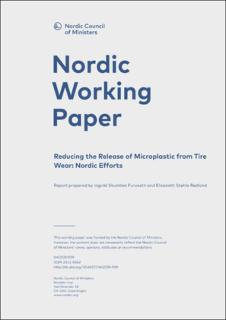| dc.description.abstract | Tire wear is the single most important source of microplastic particles in the Nordic countries. Commissioned by the Nordic Working Group for Circular Economy (NCE), NIVA has assessed the Nordic efforts against microplastic leaching from tire wear to the marine environment. The main source of tire wear to the marine environment are likely untreated runoff from roads with direct discharge to the marine recipient, such as tunnel wash water or runoff from major roads where the drainage system has discharge directly to the recipient. According to our findings, none of the Nordic countries have implemented specific measures against microplastic leaching from roads to the marine environment. However, targeted efforts against particle emission and pollution from road and tire wear in general may reduce the emissions of microplastic as well. Efforts to reduce local air pollution caused by road dust will likely also reduce microplastic emissions, a component in road dust. Relevant examples are environmental speed limits (ESL), reduction in traffic volume and limits to use of studded tires. Norway has implemented ESL, while several countries have addressed studded tires. Reducing the traffic volume is a strategy sought by all Nordic countries. Current knowledge of tire wear particles, microplastic particles and general road pollution indicates that a large fraction of particle-related pollution is retained in the roadside area and in any treatment that has sufficient capacity for sedimentation from runoff. Treatment of runoff, particularly in “hotspots”, can be a cost-effective method of reducing microplastic emissions to the environment. However, our findings suggest that the countries probably have far fewer treatment systems for road runoff in place than needed (e.g., for tunnel wash water), and the maintenance and testing of existing treatment systems are deficient. Studies on wastewater treatment plants indicate that tire particles likely are also retained, mainly in the sludge. Sewage sludge is often used as fertilizer in agriculture, thus the potential of a second pathway from farmland to marine recipients also exists through agricultural runoff and should be addressed. We recommend the following actions: - In collaboration with the research community, continued focus on the development of standardized analytical methods for quantifying tire particles in environmental samples. - Studies on the mass flow of tire wear particles. This should be included in monitoring programmes and research projects on retention in different environmental compartments. - Incorporation of appropriate requirements for water treatment of road and tunnel runoff in discharge permits, based on updated knowledge. - Continued research on the efficiency of retention for various water treatment techniques, so that future projects may choose the most optimal design to capture microplastic particles. - Investigation of the adequacy of the proposed measures and policy instruments to reduce microplastic pollution, including their cost-effectiveness and co-benefits. Implications for other policy areas should be considered. - Knowledge sharing and collaboration between countries. We encourage the Nordic countries to follow and contribute to developments at the EU level (e.g., standard wear test, tire label, regulations) | |
